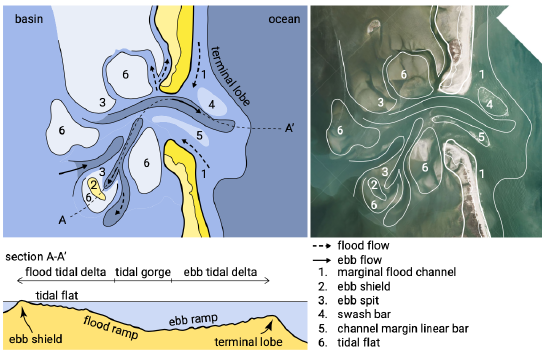9.3.2: Tidal deltas
- Page ID
- 16400
Because of the large tidal discharges and hence velocities in the inlet or estuary mouth, there is a strong sediment exchange between the basin and the outside area. Especially in constricted inlets, this leads to the formation of extensive sand deposits at either side of the entrance, which are called tidal deltas. In the divergent ebb-tidal discharging flow, the flow velocities decrease and sediment is deposited, thus creating the ebb-tidal delta. Just as the ebb-tidal delta consists of material deposited by the diverging ebb flow leaving the inlet, the flood-tidal delta is created by sediment deposited by the inflowing flood current. Consequently, basins with large tidal ranges (and limited wave influence) tend to have well-developed ebb- and flood-tidal deltas and very deep inlet gorges.
The ebb- and flood-tidal deltas are dissected by channels followed by the tidal currents. The flats and channels exhibit a highly dynamic behaviour; their locations are continuously changing with time.

Figure 9.6 shows a sketch of a barrier inlet system with typical flood- and ebb-tidal deltas. The boundaries of the ebb-tidal delta can be found via the no-inlet bathymetry, where the differences in bottom height are nil between the actual and no-inlet bathy-metry of the adjacent coast (Fig. 9.20).
A typical ebb-tidal delta includes:
Marginal flood channels Marginal in the context of marginal flood channels is used to indicate the positioning of the flood channels to the sides of the inlet. It is not used to indicate that they are of marginal importance or marginal in size; for instance, in the estuaries at the SW of the Netherlands the marginal flood channels are quite distinct.
Main ebb channel The occurrence of separate ebb- and flood dominated tidal channels can be explained as follows. In the beginning of the flood cycle, the water in the main ebb channel continues to flow seaward as a result of inertia. As a consequence water initially enters the basin via the path of least resistance, around the margin of the delta.
Channel margin linear bars These flank the ebb tidal channel and are built up from deposits as a result of the interaction of flood- and ebb-tidal currents with wave- generated currents. In the Dutch inlets, these distinct bars are not recognisable; instead, there are wide flats.
Terminal lobe A rather steep seaward-sloping body of sand, which forms the outer end of the ebb-tidal delta.
Swash platforms and bars The main ebb channel is flanked by swash platforms,which are broad sheets of sand. On these swash platforms, isolated swash bars can be recognised, built up by swash action of waves (the water that washes up on the platforms after waves have broken). Marginal flood channels usually occur between the barrier islands coast and the swash platforms.
The flood-tidal delta may be fan or horseshoe shaped with a flood ramp that slopes upward ending in the ebb shield, the most elevated outer edge of the flood-tidal delta (Fig. 9.6). The ebb shield is the flood-tidal deltas equivalent of the terminal lobe and helps to divert ebb-currents along the margins of the flood-tidal delta. The flood currents follow the shallowing flood ramp and the flood channels that continue from the flood ramp. The ebb currents (and their interaction with the flood currents) are responsible for the ebb spits and the bar-like spillover lobes.
For relatively small basins with abundant sediment supply, such as the Wadden Sea, the flood-tidal delta spans the entire basin area, viz. flood-tidal deposits are found everywhere in the basin. For the Wadden Sea we therefore generally only speak of the outer delta (Dutch: ‘buitendelta’) and the basin; the term flood-tidal delta is not mentioned as a separate morphological unit. This is quite contrary to, for instance, the USA East Coast basins, which have relatively small distinct flood-tidal deltas (as in Fig. 9.6). In these cases, the flood-tidal deltas can be regarded as the morphologically active parts of otherwise morphologically inactive basins. Following our Dutch experience, where the entire basin acts as a flood-tidal delta, we will focus on the ebb-tidal delta in Sect. 9.4. The flood-tidal delta is not treated separately, but in Sect. 9.6 on basins.
The overall morphology of the tidal deltas, especially the ebb-tidal delta, depends on the combined action of waves and tides. Wave action is generally considered to act as a bulldozer on the tidal inlet morphology (Hageman, 1969); it moves sediment onshore and limits the area over which the ebb-tidal delta can spread out. Hence the ebb-tidal delta morphology is generally determined by the (dynamic) balance between a net offshore directed sediment flux induced by the inlet currents (building up the ebb-tidal delta) and a net onshore directed sediment flux induced by offshore waves (removing sediment from the ebb-tidal delta). It is the flood-tidal delta that benefits from this onshore sediment flux. Therefore, for tide-dominated entrances, viz. with limited wave action, ebb-tidal deltas tend to be large relative to the flood-tidal delta. For wave-dominated entrances, the ebb-tidal deltas tend to be relatively small, whereas the flood-tidal deltas are well-developed with flood shoals that can be emergent at low tide.


